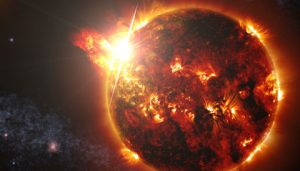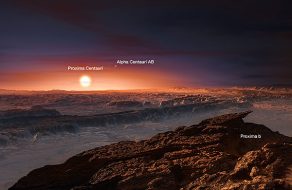Astronomers suspect the Sun’s closest stellar neighbor, Proxima Centauri, desiccated its potentially rocky exoplanet, destroying the planet’s chances for habitability.
There’s been lots of speculation about the little world known as Proxima Centauri b since astronomers announced its discovery last August. With a minimum mass of 1.3 Earths, the exoplanet orbits its star at roughly one-tenth the distance that Mercury loops the Sun. Yet because Proxima Centauri is a red M dwarf — the runts of the stellar litter — this total lack of personal space puts the world in the star’s putative habitable zone, the region where, given an Earth-like atmosphere and rocky composition, there’s the right amount of incoming starlight to sustain liquid surface water.

NASA Goddard Space Flight Center / S. Wiessinger
But results presented earlier this month at the winter American Astronomical Society meeting in Grapevine, Texas, suggest that being in this sweet spot might have instead spelled Proxima Centauri b’s doom.
Dangerous M Dwarfs
Before they become full-fledged, hydrogen-fusing stars, the smallest red dwarfs spend a few hundred million years contracting. During this stage, they’re much brighter than they will be during their adult years, by roughly a factor of 50, said Edward Guinan (Villanova University) during a session on January 4th. Furthermore, young M stars shoot out gads of X-ray and ultraviolet radiation — roughly 100 times as much in X-ray and 10 to 20 times as much in UV as those dwarfs as old as the Sun.
Adding insult to injury, these young stars unleash dangerous flares, and if an orbiting world has a weak or nonexistent global magnetic field, the star’s winds could tear the atmosphere off the planet. “If you have a weak magnetic field, you’re done for,” Guinan said. “There’s really no way to survive.”
All these factors put together mean that, in Proxima Centauri’s earliest days, its habitable zone was farther out than it is now. If the exoplanet formed where it currently resides (in the modern habitable zone), then the world “underwent a living hell in its early 300 to 400 million years,” Guinan said.
For the past decade, Guinan and his team have been pursuing a project called Living with a Red Dwarf. They’re amassing data on all the small, cool M dwarfs within about 30 light-years of Earth, trying to understand their rotation rates, starspottiness, ages, and more. Given what they’ve learned from that work, Proxima Cen b is most likely a desert world.
Victoria Meadows (University of Washington), who presented in the same session, has come to the same conclusion. She and her colleagues considered different potential atmospheres and ran simulations to determine how the exoplanet might look today, about 5 billion years after its formation. They determined that, if there were surface water, the incoming radiation likely would have evaporated most or all of it. And since water is made of oxygen and hydrogen, and hydrogen is more easily yanked from a planet’s gravitational grasp, the process could have built up a large, oxygen-rich atmosphere. A carbon dioxide–rich, Venus-like atmosphere is another possibility.

ESO / M. Kornmesser
Alternatively, Proxima Centauri b might indeed be habitable if it started out with a protective, hydrogen-rich envelope, or if it formed farther from the star — and thus farther from the deadly radiation — and then migrated to its current, close position. Forming farther out would also be good for its chances for water, because ices are more prevalent in the outer reaches of planet-forming disks: the little world might then have had a repository of ice that, when it scooted in closer to the M dwarf, melted into seas.
Assuming it’s rocky, that is: astronomers only have a minimum mass for the exoplanet. It could instead be like Uranus and Neptune.
The Other Closest Habitable-Zone Worlds
There are, however, other nearby, potentially habitable worlds. In their study, Guinan’s team looked at two additional exoplanets: Kapteyn b (13 light-years away) and Wolf 1061 c (14 light-years). Both planets are just over half again as wide as Earth, with minimum masses of 4 to 5 Earths, and both are in their stars’ habitable zones. Notably, Kapteyn’s star is roughly 11 billion years old and probably stolen from a dwarf galaxy.
Given the stars’ ages and their X-ray and ultraviolet outputs, the team determined that Wolf 1061 c also has poor chances for habitability. But Kapteyn b looks favorable. It currently receives 8 times more X-ray influx from its star than Earth does from the Sun, and less than twice Earth’s ultraviolet level. At 0.17 Earth-Sun distances, Kapteyn b is also 3½ times farther from its M dwarf than Proxima Cen b is from its. It might potentially have been far enough out to weather the dwarf’s violent youth.
References:
Victoria Meadows et al. “Proxima Centauri b: Environmental States and Observational Discriminants.” 229th American Astronomical Society. Abstract 120.03.
Edward Guinan, Scott Engle, Ignasi Ribas. “Beyond Proxima b: Investigating the Next Nearest Potentially Habitable Exoplanets: Kapteyn b (13 LY) and Wolf 1061 c (14 LY) — Assessing Their Suitability for Life.” 229th American Astronomical Society. Abstract 120.04.
Gain a new appreciation for our own star by joining one of Sky & Telescope's tours for the August 2017 total solar eclipse.
 5
5
Comments
BREAKTHROUGHENERGYGUY
January 16, 2017 at 7:26 pm
A sleeping invention by Dr. Robert L. Carroll (1910-1997) a mathematical physicist - could open space to human exploration far beyond present ideas. Carroll’s Ultra-Cold Disruption (UCD) is a revolutionary alternative to any form of fission or fusion. The fuel is very small amounts of ordinary water. There is no radioactive waste. Carroll was aiming for the stars. His alternative to relativity proposed the maximum speed of a spacecraft is 20 million times that of light. If it proves practical, UCD could initially be used to generate power. Carroll believed it would be safe enough for vehicles. It might also replace chemical rockets with a system that cannot explode and would be much lighter and cheaper. That would allow humans to settle in space in great numbers. AESOP Energy intends to prototype the breadbasket sized reactor. A possible early application is replacement of fuel in an 18 wheel truck. A spacecraft design firm, once convinced it is worth pursuing, has indicated interest in exploring the replacement of chemical rockets with UCD. The invention depends on room temperature superconductors. Polymer Ultraconductors are equivalents - proven by four successful government Small Business Innovation Research contracts. Once UCD proves practical, a nanoscale spacecraft can be launched aimed at a star. If it quickly returns with data and photographs consistent with the Hubble telescope, Carroll will have been proven correct. See: aesopinstitute.org look under MORE.
You must be logged in to post a comment.
Dr. E. F.-Milone
January 20, 2017 at 5:37 pm
Neither special nor general relativity is in doubt, as a very large number of successful experiments have attested. Therefore your faster than light theory must be in doubt. In particular, it would take an infinite amount of energy to accelerate any finite mass to the speed of light. As to cold fusion or whatever UCD claims to be, a theory is useless unless it can be repeatedly verified by independent scientists.
You must be logged in to post a comment.
Robert-Casey
January 17, 2017 at 2:46 pm
If the planet has plate tectonics, that might have sequestered some water and gases long enough to weather the star's early years.
You must be logged in to post a comment.
StanR
January 21, 2017 at 12:39 am
Perhaps the planet might have acquired some water if "lucky" enough to have been subjected to a bombardment of comets after the star had cooled sufficiently.
You must be logged in to post a comment.
Trevor W. Goodchild
October 10, 2021 at 10:43 am
Are there any moons orbiting Proxima b? What stars would be the most visible in Proxima b's skies?
You must be logged in to post a comment.
You must be logged in to post a comment.